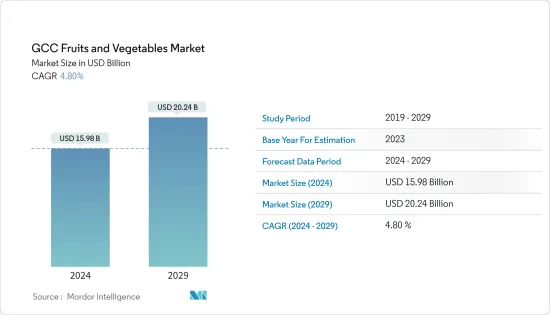PUBLISHER: Mordor Intelligence | PRODUCT CODE: 1536809

PUBLISHER: Mordor Intelligence | PRODUCT CODE: 1536809
GCC Fruits And Vegetables - Market Share Analysis, Industry Trends & Statistics, Growth Forecasts (2024 - 2029)
The GCC Fruits And Vegetables Market size is estimated at USD 15.98 billion in 2024, and is expected to reach USD 20.24 billion by 2029, growing at a CAGR of 4.80% during the forecast period (2024-2029).

The GCC countries, a multicultural population of foreigners, have various cuisines and a varied demand for fresh food products. In addition, governmental efforts to tackle the high levels of obesity, diabetes, and cardiovascular diseases among the population have brought about changes in local consumption patterns. Therefore, consumers are willing to spend more on fresh, high-quality, flavorful, safe, and convenient produce due to changing food preferences. However, the growing population of Bahrain, Kuwait, Oman, Qatar, and Saudi Arabia led to increased dependence on imported food staples due to decreasing groundwater and aquifer levels in the Arabian Peninsula, limited rainfall, arid climate, and escalating soil salinity. Therefore, the governments of these countries have set out strategies to decrease their dependence on imported food, leading to significant growth in the farming and agriculture industries in the region. Moreover, various regional companies are investing in cultivating domestic fruits and vegetables, incorporating advanced farming techniques to ensure consistent consumer supply throughout the year and reduce reliance on imported goods. For instance, VFarms, a Qatar Science & Technology Park (QSTP) member, presented its state-of-the-art indoor cultivation facilities at Expo 2023 Doha, emphasizing sustainable farming practices in Qatar. This facility allows farmers to grow crops using atmospheric water collected through solar power, enabling year-round cultivation of various crops, such as vegetables and berries, regardless of seasonal changes.
GCC Fruits and Vegetables Market Trends
Increasing Adoption of Technology in Horticulture
The agricultural sector in the GCC countries encounters distinct difficulties because of dry climates and scarce natural resources. Therefore, innovative methods like hydroponics, vertical farming, and controlled-environment farming are increasingly used to efficiently utilize resources, lower water usage, and increase crop production. These methods allow farmers to improve crop yields and reduce losses from environmental factors by utilizing advanced irrigation systems, precision agriculture tools, and genetic modifications. For instance, in 2022, the Institute of Urban Agriculture (IUA) of the Chinese Academy of Agricultural Sciences (CAAS) enhanced vegetable production in Qatar by implementing a new method that combines hydroponics and solid active fiber soil, known as the Leitu technique. This technique uses an ecological material made from straw, cotton stalks, and other agricultural and forestry waste instead of soil. The Leitu technique allows for cultivating a comprehensive range of vegetables, such as leafy greens, eggplants, tomatoes, and cucumbers.
Saudi Arabia is the Biggest Consumer of Fruits and Vegetables
The increasing health awareness among consumers, especially millennials, has driven the demand for fresh produce, such as fruits. Fruits are highly nutritious and loaded with vitamins C and A, nutrients, minerals, and other necessary antioxidants, so their demand has increased among consumers over the last few years. The country largely depends on imports to meet its fruit consumption needs.
People in Saudi Arabia have developed a preference for different types of grapes. A higher demand for varieties, such as red grapes, with large seeded sweet-tasting berries. Grapes yield large amounts of juice and take many forms in the food processing industry. Fresh grapes are usually popular among Arabs to be eaten raw in the fall and sometimes throughout the year. They are frequently served as a dessert, often with cheese, creating an exquisite combination. Moscatel grapes are served with foie gras, a specialty food made from the liver of a duck or goose. Grapes can also be combined with other fruits to create an exquisite Macedonian dish. While nearly half of all grapes are used to make wine, one-third is consumed as fresh fruit, and the remainder is dried, consumed as grape juice, or stored as grape musts (concentrated and non-concentrated).
Additional Benefits:
- The market estimate (ME) sheet in Excel format
- 3 months of analyst support
TABLE OF CONTENTS
1 INTRODUCTION
- 1.1 Study Assumptions and Market Definition
- 1.2 Scope of the Study
2 RESEARCH METHODOLOGY
3 EXECUTIVE SUMMARY
4 MARKET DYNAMICS
- 4.1 Market Overview
- 4.2 Market Drivers
- 4.2.1 Increasing Adoption of Technology in Horticulture
- 4.2.2 Government Initiatives for Self-reliance in Vegetable and Fruit Farming
- 4.3 Market Restraints
- 4.3.1 Limited Resource Availability and Unfavourable Climatic Condition
- 4.3.2 Increasing Reliance on Imports for Domestic Supply
- 4.4 Value Chain Analysis
- 4.4.1 Value Chain Analysis - Overview
- 4.4.2 Value Chain Analysis - Price Markup
- 4.4.3 Stakeholders Analysis
- 4.4.4 Issues and Challenges Involved
5 MARKET SEGMENTATION
- 5.1 Geography (Production Analysis(Volume), Consumption Analysis (Value and Volume), Import Analysis (Value and Volume), Export Analysis (Value and Volume), Price Trend Analysis)
- 5.1.1 United Arab Emirates
- 5.1.1.1 Fruits
- 5.1.1.2 Vegetables
- 5.1.2 Bahrain
- 5.1.2.1 Fruits
- 5.1.2.2 Vegetables
- 5.1.3 Kuwait
- 5.1.3.1 Fruits
- 5.1.3.2 Vegetables
- 5.1.4 Oman
- 5.1.4.1 Fruits
- 5.1.4.2 Vegetables
- 5.1.5 Qatar
- 5.1.5.1 Fruits
- 5.1.5.2 Vegetables
- 5.1.6 Saudi Arabia
- 5.1.6.1 Fruits
- 5.1.6.2 Vegetables
- 5.1.1 United Arab Emirates
6 INTERNATIONAL TRADE AND PRICE SCENARIOS
- 6.1 Onion
- 6.2 Potato
- 6.3 Tomatoes
- 6.4 Garlic
- 6.5 Cauliflower
- 6.6 Beans
- 6.7 Eggplant
- 6.8 Lemons
- 6.9 Apples
- 6.10 Bananas
- 6.11 Grapefruit
- 6.12 Dates
- 6.13 Cabbage
- 6.14 Watermelon
- 6.15 Mango
- 6.16 Chilies
- 6.17 Strawberries
7 COMPETITIVE ANALYSIS
- 7.1 List/Profile of Major Retailers
- 7.2 Strategies Adopted and Recent Events
8 MARKET OPPORTUNITITES AND FUTURE TRENDS




